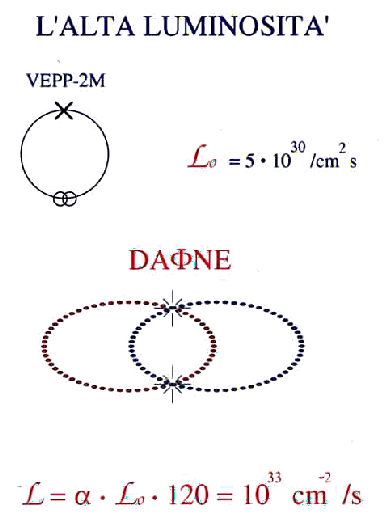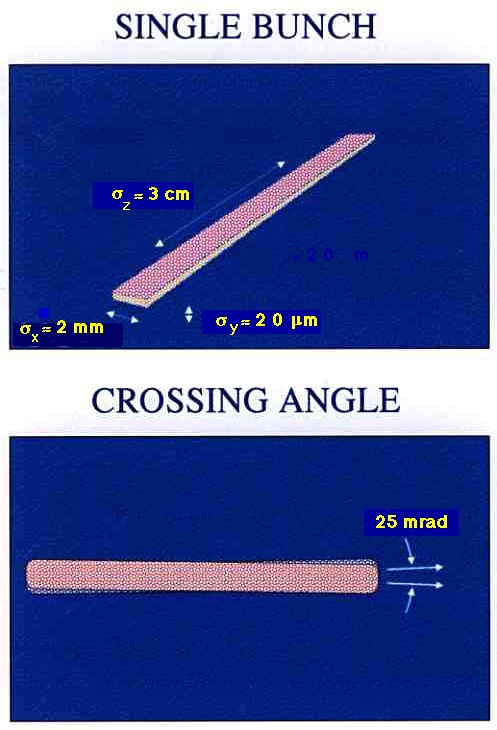
DAFNE is a Phi-factory, mainly dedicated to the study of CP violation. The Phi-resonance (1.02 GeV c.m) can be created by annihilating electrons and positrons in a storage ring with a peak cross-section of ~5x103 nanobarn. ~50% of the Phi decay into a couple of charged K mesons, while ~35% create a couple of neutral Klong + Kshort. The Klong decays normally into 3 pions, the Kshort into 2 pions. In the CP violating decay, the Klong decays into only 2 pions and this happens in only 0.3% of the decays. Sufficient statistical accuracy in the observations for the KLOE experiment requires ~2x107 CP violating decays per year. Under normal operating conditions, a luminosity near 1033 cm-2s-1 is needed to fulfil this requirement.
The luminosity is a typical figure of merit of a storage ring collider, proportional to the number of interactions per unit time between the particles of the counterrotating beams. In the case of an electron/positron collider, it is the product of the number of electrons stored in each bunch times the number of positrons stored in each bunch times the frequency of bunch crossings at the interaction point, divided by the cross section area of the beam at the crossing point.
The number of particles which can be stored in a bunch is limited by the beam-beam interaction, which introduces a strong non-linearity in the beam dynamics, leading to beam blow-up and loss. This limit becomes less severe when the energy of the stored particles increases.
The effect of beam-beam interaction can be reduced by strongly focusing the beam at the interaction point (the so called "low-beta" technique) by means of strong magnetic lenses. Of course, these lenses create chromatic perturbations in the particle motion, which need to be corrected outside the crossing region. For this reason, only a limited number of low-beta crossing points (one or two) can be realised in a small low energy collider such as DAFNE.
The luminosity required for the CP violation experiment is two orders of magnitude larger than the maximum obtained until now in a collider at the same energy, namely at the VEPP-2M storage ring in Novosibirsk. This is a "conventional" storage ring, where a single bunch of electrons and a single one of positrons circulate in opposite directions in the same vacuum vessel, crossing in a low-beta interaction point and being separated at the opposite point in the ring by means of electrostatic fields. This separation can be easily performed in the case of a single bunch but becomes a critical item when many bunches are stored in the ring. The luminosity given by VEPP-2M is at the limit of the beam-beam instability at the Phi resonance energy.
In order to gain the required improvement in luminosity, an alternative collider scheme has been proposed for DAFNE, where the beams are stored into two separated rings, both lying in the same horizontal plane, and crossing in two opposite low-beta sections at a small horizontal angle. In this way, many bunches can be stored in each ring, each bunch being perturbed by the beam-beam interaction only twice during each revolution. The luminosity is then proportional to the number of stored bunches, up to 120 for the DAFNE Main Rings.

Numerical simulations and accelerator studies have shown that the crossing at an angle of the beams does not introduce additional limitations to the beam-beam interaction, provided the transverse size of the beam in the plane of the crossing (horizontal in the case of DAFNE) is larger, typically by an order of magnitude, than the bunch length times the crossing angle. For this reason a flat shape has been chosen for the beam, the horizontal size at the crossing point being 100 times larger than the vertical one. This choice implies also that strong focusing is needed only in the vertical plane at the crossing point, thus simplifying the design of the low-beta region and the chromatic correction system.

Accelerator experiments performed on storage ring in operation or already shut down have shown that radiation damping, an effect coming from the intense synchrotron radiation emission form the particles inside the storage ring bending fields, is a relevant parameter in the beam-beam interaction limitation to the maximum achievable luminosity. High energy storage rings can in fact achieve much higher luminosities than low energy ones, and this is due not only to the larger mass of the interacting particles, but also to the larger amount of synchrotron radiation produced at high energy. The radiation, however, can be increased in low energy rings by inserting in the lattice special magnets of alternating polarity, called "wigglers". In the DAFNE Main Rings 8 wigglers will increase by a factor of 2 the synchrotron radiation power emitted by the particles in the bending magnets.
All the above described choices for DAFNE make the realisation of the facility mainly a technological challenge, the feasibility of all "fundamental" items, such as beam-beam interaction, being already demonstrated in operating storage rings. Damping of instabilities due to the large number of stored bunches and vacuum problems related to the large total stored currents are the major technological challenges of the DAFNE Project.
| Single beam energy | 0.51 GeV |
| Number of particles per bunch | 8.9x1010 |
| Number of bunches per ring | up to 120 |
| Crossing frequency | up to 368.25 MHz |
| Horizontal emittance | 1.0 mm.mrad |
| Vertical emittance | 0.01 mm.mrad |
| Coupling factor | 0.01 |
| Horizontal beta function at crossing | 4.5 m |
| Vertical beta function at crossing | 0.045 m |
| Total crossing angle in the horizontal plane | 20 to 30 mrad |
| Horizontal beam-beam tune shift per crossing | 0.04 |
| Vertical beam-beam tune shift per crossing | 0.04 |
| Bunch length | 30 mm r.m.s. |
| Horizontal beam size at crossing | 2.0 mm r.m.s. |
| Vertical beam size at crossing | 0.02 mm r.m.s. |
| Synchrotron radiation loss per turn | 9.3 KeV |
| Horizontal betatron damping time | 36 msec |
| Vertical betatron damping time | 36 msec |
| Longitudinal damping time | 17.8 msec |
| Maximum stored current per ring | 5.2 A |
| Maximum luminosity | 5.3x1032 cm-2 s-1 |